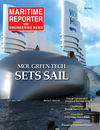
Page 14: of Maritime Reporter Magazine (May 2023)
Green Ship Technologies
Read this page in Pdf, Flash or Html5 edition of May 2023 Maritime Reporter Magazine
Classi? cation ever, it is likely that newbuildings will contribute to the further lead to catastrophic technical problems. Data sharing can also expansion of remote surveys. A shipping company’s decision negate the need for opening machines for audit inspections.
to accept the CAPEX and OPEX for increased communication Moving forward, digital twins of in-service ships will be- and other necessary items depends on various factors beyond come more commonplace. The aim is to virtually reconstruct a remote survey functionality. The use of remote surveys also 3D model of an existing ship using images collected by drones requires ship-side preparation and crew member pro? ciency. during surveys, together with scanning and photogrammetric
Tihomir Kezic, Digital Solution & Transformation Direc- technologies. This would allow for hotspots and other vulner- tor, Bureau Veritas (BV), says: “The transition from reactive able areas to be recorded throughout the ship’s inspection his- and time-based maintenance to condition-based and predic- tory using 3D visuals.
tive maintenance will bring tremendous bene? ts to machinery “3D models are important to fully understand the multiple maintenance activities, with increased reliability and an up- phenomenon that can affect the condition of the ship’s hull ward trend in ROI for vessel owners.” and machinery,” says Kezic. “For example, they can help in
New digital capabilities will also enable “infant failures” of carrying out Operational De? ection Shape (ODS) to deter- machinery components to be spotted before they escalate and mine the vibration patterns and dominant frequencies respon- sible for structural and machinery issues.”
Joseph Morelos, Maritime AI Applications Innovation Lead- er at Lloyd’s Register (LR), notes that using AI in advanced monitoring such as anomaly detection, fault detection and iso- lation, and diagnostics and prognostics can increase operational safety and productivity by preventing failures and collateral damage. “Class should make sure that the AI systems employed by the owners are effective, dependable and safe. Once these systems are proven they can be scaled to improve the opera- tions, reliability and safety of the ? eet, resulting in a common win for owners, OEMs, insurers, class and regulators.”
To support this, LR has implemented assurance frameworks for maritime AI systems. In 2022, it announced a collaboration with the Alan Turing Institute which provides fast and cost-
CLassNK
China Classi? cation Society 14 Maritime Reporter & Engineering News • May 2023
MR #5 (1-17).indd 14 5/1/2023 9:35:12 AM

 13
13

 15
15
